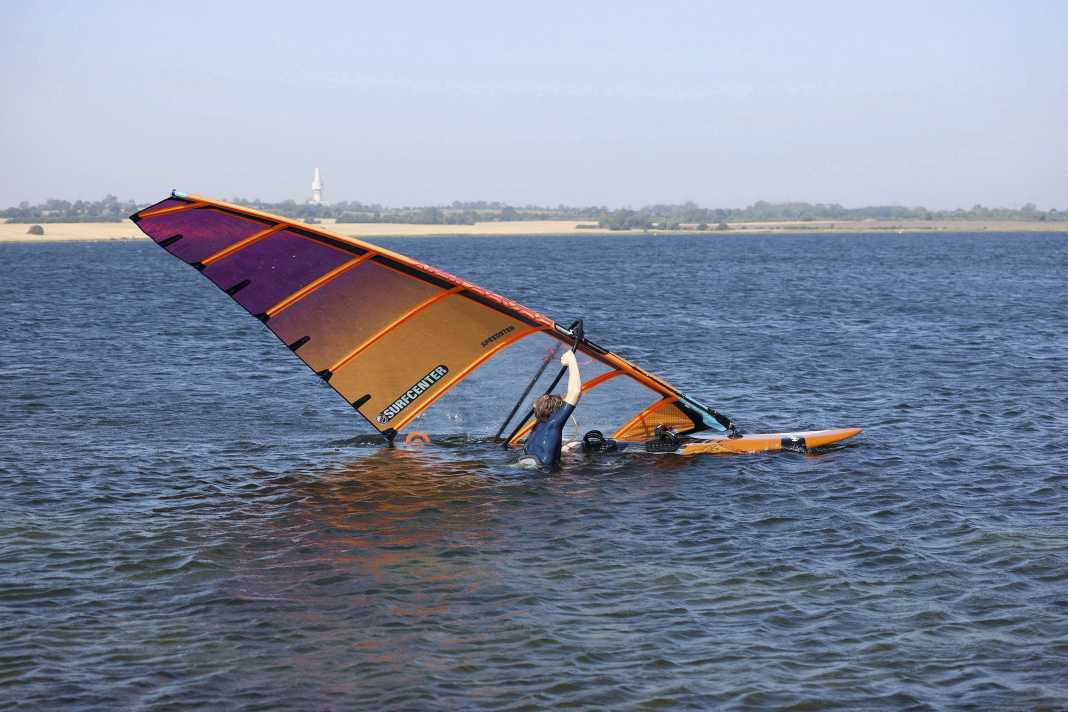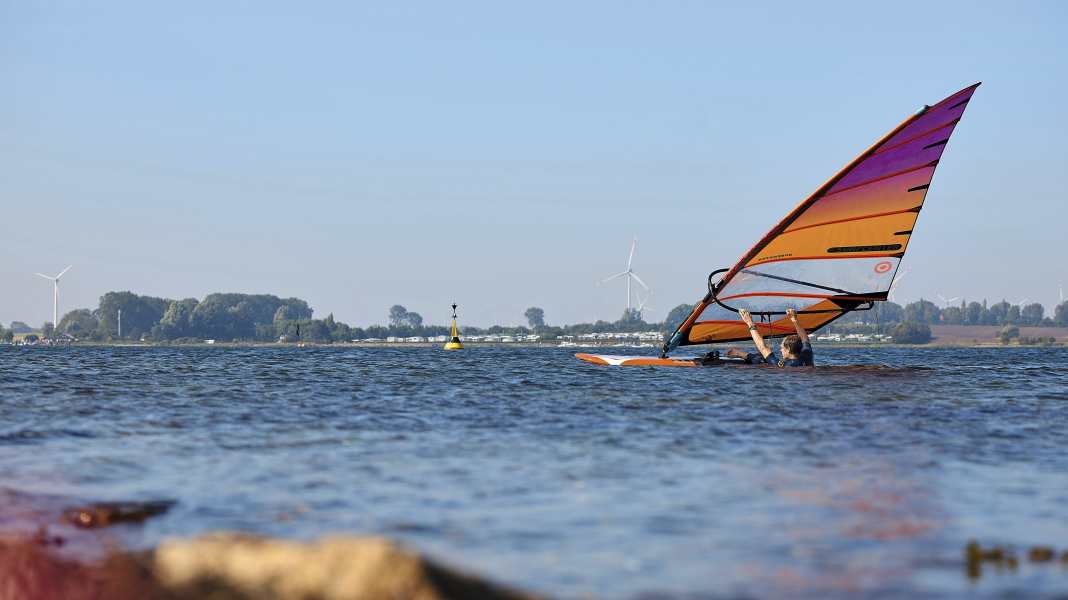
Without a doubt, positioning yourself in the water and turning your equipment after a fall are some of the biggest hurdles when water starting. The good news is that how quickly you get into the water start position depends only partly on your strength, but primarily on the right strategy and the right technique.
The water start is the basic requirement for surfing on small fun boards. However, if you have not yet mastered the water start, you should use a board with a little excess volume (body weight + 30/50 litres = recommended board volume). If the water start doesn't work or takes too long, you can always switch to a sheet start in an emergency. It is at least as important not to use sails that are too heavy during the learning phase. Camber sails in particular are problematic at the beginning because they have a wide mast sleeve that swallows up a lot of water. It is also sometimes difficult to push the rigid profile of camber sails to the other side in the water. Camberless freeride, freemove or wave sails with thin RDM masts have a clear advantage in this respect!
The quickest way to get into the water start position often depends on the direction in which you want - or need - to start. If it doesn't really matter, it makes sense to let the equipment decide. So instead of laboriously turning everything round, it can make sense to start in the other direction and turn round with a tack or jibe. We'll show you the quickest way back onto the board for both options below.
Aligning the sails for the water start
Same direction - Variant 1: Let the sails change direction
After a crash, do you want to start in the direction in which the board is already lying? Unfortunately, the sail is often upside down in the water, with the boom end pointing towards the tail. This means that you first have to flip the rig over in order to align the mast parallel to the tail.






Same direction - Variant 2: Align sails by sheet start
Flapping the sail (see above) can be difficult in deep water, especially with large sails. Sometimes it is easier to try the sheet start technique. If the sheet start is successful - bingo! But even if you don't master it, the sail is usually in the right position for the water start afterwards.
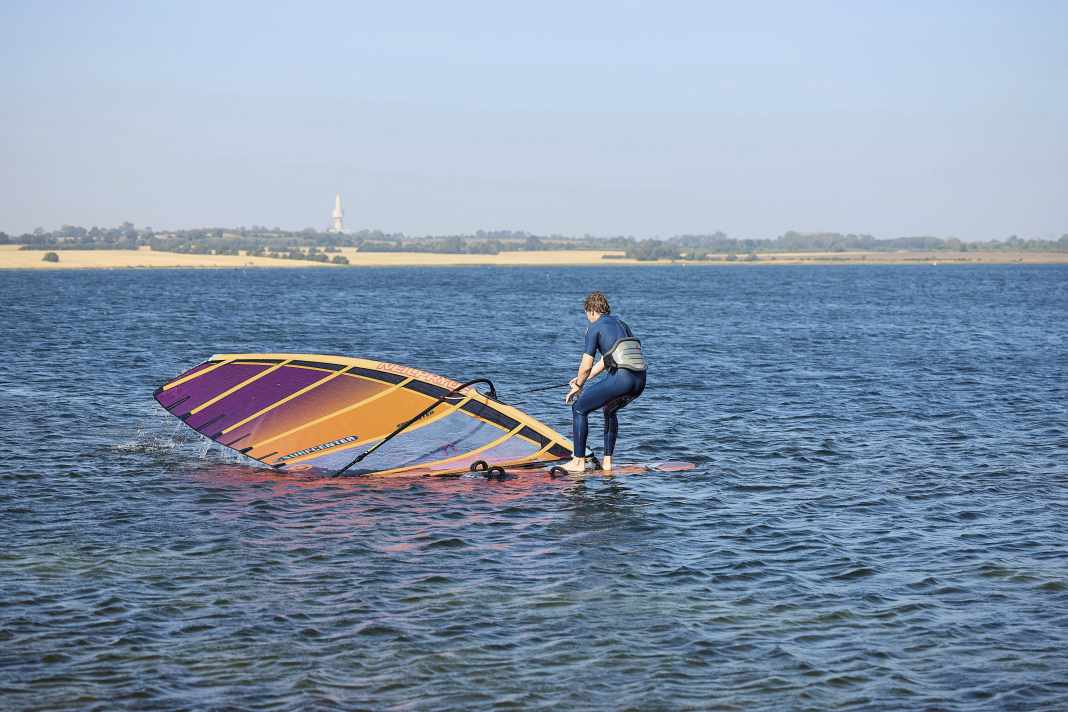





Change starting direction before the water start by turning the board
Do you want or need to start in the other direction after a crash? In this case, you have two options: Either swim a semi-circle with the sail against the wind and turn the board and rig in the desired direction. However, it is often easier to turn the board first.






Change start direction - from tack to water start
Most falls happen during manoeuvres. Especially when the jibe goes wrong again, the material is often unfavourable for a water start, with the sail to leeward. That's why we want to take up the cudgels at this point in favour of the tack, because although a fall during the critical phase of the side change is not nice, it almost always means that the material is halfway in place and you can get back on the board quickly.
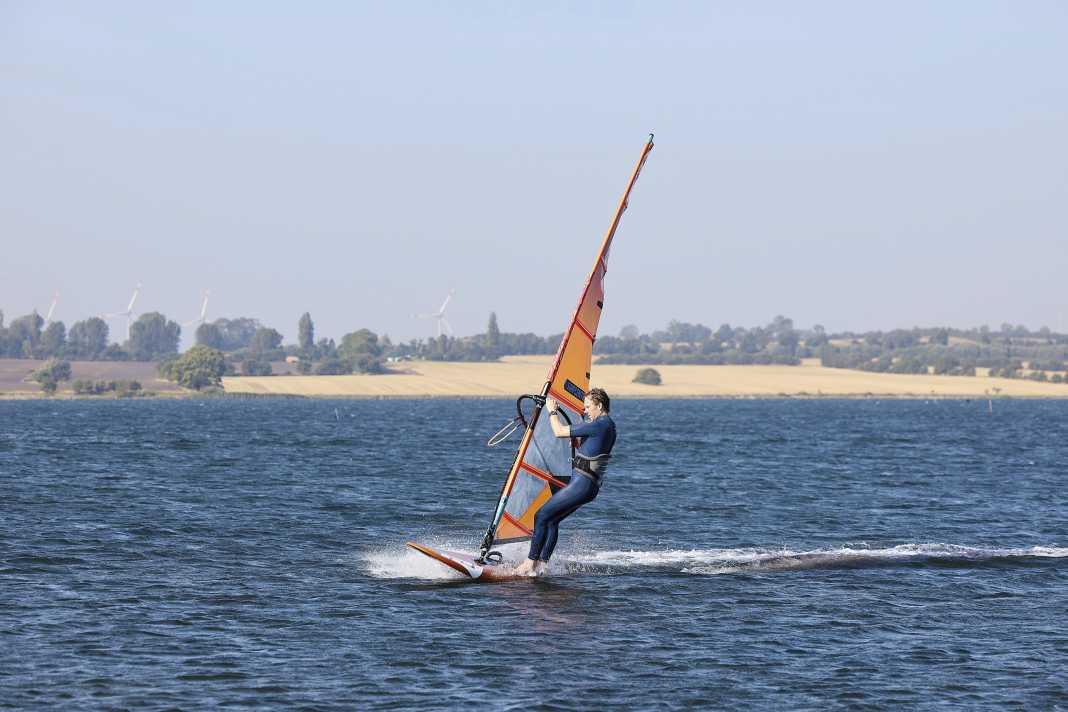





Hoist sails and set course
Do not push! Pull!
Once you have positioned and turned the sail in the water, you have already mastered one of the biggest hurdles. Your equipment is perfectly positioned when your board is orientated at right angles to the wind on a half-wind course. The sail is in a similar position so that it is being blown by the mast. Now you need to get the sail over your head so that it floats freely. The most important realisation here is that the sail is not pushed upwards, but actively pulled upwind into the wind!
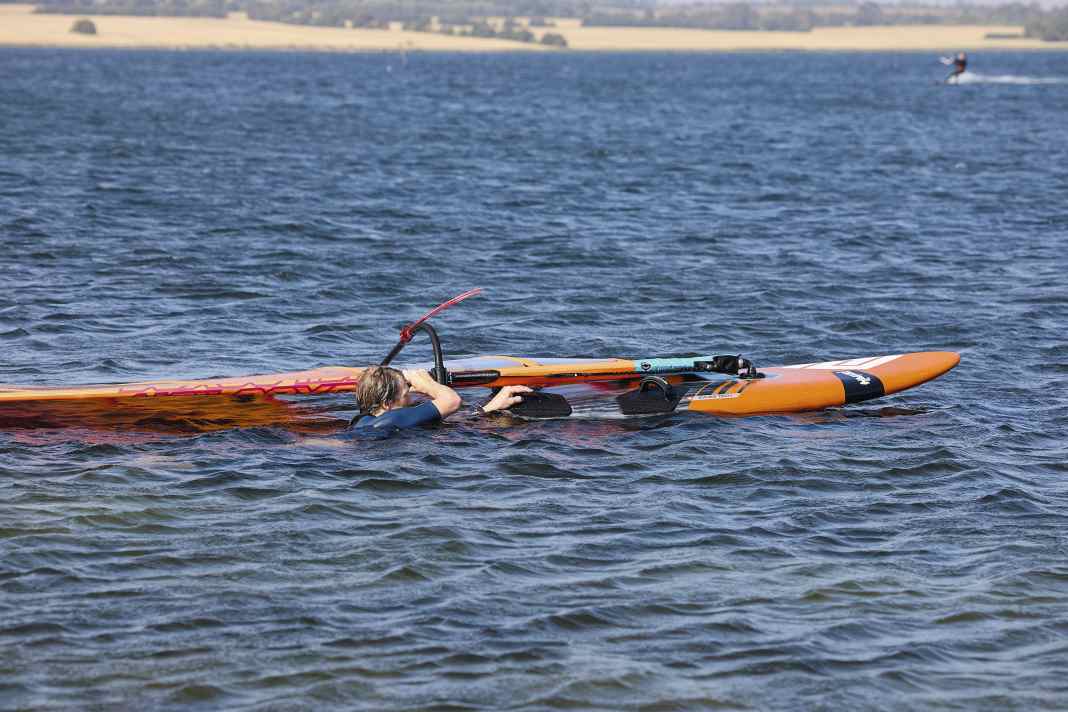





The most important moment is when you pull the sail over your head to windward with vigour. This "windward pull" has two important effects: Firstly, it resembles a downhaul and thus prevents the board from turning back into the wind from a half-wind course. Secondly, the windward pull ensures that the outhaul does not get caught in the water, which would result in an unintentional flip of the sail.
Hold course by applying pressure to the base plate
As soon as the sail floats freely above you, first grab the boom with your back hand and then - if this is not the case from the start - grab the boom with your front hand. Keep the board on a half-wind to light space wind course. During this phase, you can steer as you would when travelling straight ahead: If you tilt the end of the boom towards the water (luffing), the board will turn into the wind - this often happens unintentionally. Then you need to counteract this by dropping: push the rig forwards with your front hand and try to apply pressure to the base plate from above - this will cause the bow to turn out of the wind. As soon as you feel enough sail pull, put your back foot on the deck - ideally not on the heel, but on the inside. This puts your entire body in a forward position and, to exaggerate a little, your gaze goes past the front of the mast to leeward. This body position effectively prevents the board from luffing.
The ascent is then the final act of the water start. Important: Keep your arms fully extended - you are not pulling yourself up, you are being pulled. The back leg actively pulls the board under your body until the sail is vertical. Only at the very end do you put your front foot on the deck directly behind the base plate.
Only the legs are pulled up when climbing onto the board. The arms remain long until the end."
Push the sail profile in the right direction
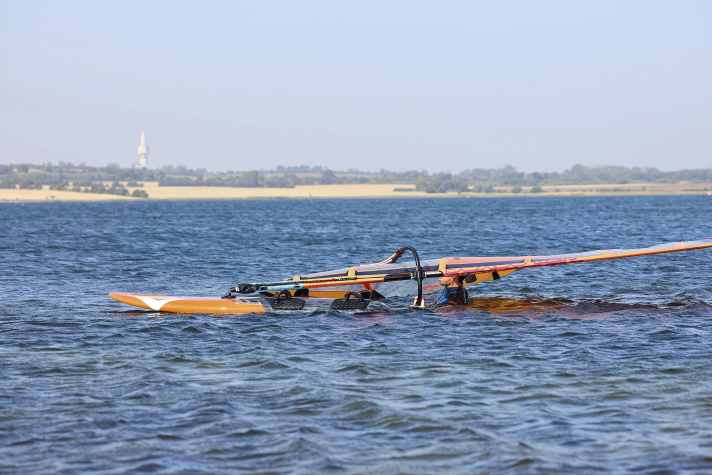
Many large sails are profiled, especially camber sails have a rigid profile, which must first be pushed upwards before the water start so that it can produce lift like an aeroplane wing. So once you have the board aligned across the wind, it's time to push the batten upwards with your back hand or with a loving headbutt. In general, however, camberless sails with a flatter profile (e.g. wave, freemove or freeride category) are much better suited to learning how to waterstart.
The most common mistakes when preparing for a water start
Mistake 1: Placing the boom on the tail

If you can put the boom on the tail (see picture above), it's easier, no question. So if you are short and mount the boom low down anyway, this trick is absolutely legitimate. However, deliberately mounting the boom lower and even screwing the base plate all the way forwards just to be able to "cheat" at the water start is not a good idea, because: A boom that is too low in combination with short harness lines results in greater lateral forces and poorer planing. Control in gusts is also difficult with short harness lines and the risk of skidding increases.
Low boom or base plate forwards to "cheat" the water start is not a good idea
In addition, a base plate mounted at the front pushes the bow down, preventing the board from gliding freely and also increasing the risk of skidding. It is therefore essential to pay attention: The boom should be mounted on land at least at shoulder height, and even slightly higher for wide boards. Accordingly, harness lines with a length of 26 to 30 inches are recommended. If you can still put your boom on the tail when set up like this - lucky you. If not, you shouldn't sacrifice early planing and control just to be able to waterstart more easily. The water start is only a means to an end. Therefore, you shouldn't ruin your setup just to be able to waterstart a little easier
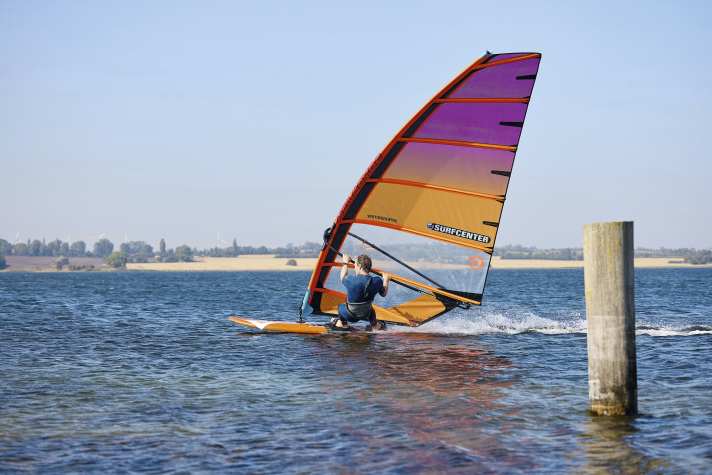
Mistake 2: Pushing up the sail
The board and rig have just been nicely (and sometimes laboriously) aligned for a half-wind course, and then it's all gone again. If the outhaul gets caught in the water when raising the sail, the result is usually an uncontrolled flip. This is often caused by the sail being pushed up the mast to get wind underneath it. Instead, the aim should be to pull the sail upwind and forwards: Grab the sail either far forward on the boom or above the boom on the mast, with your back hand resting on the tail. Now pull the sail forwards and upwind over the head so that the outhaul comes free.
